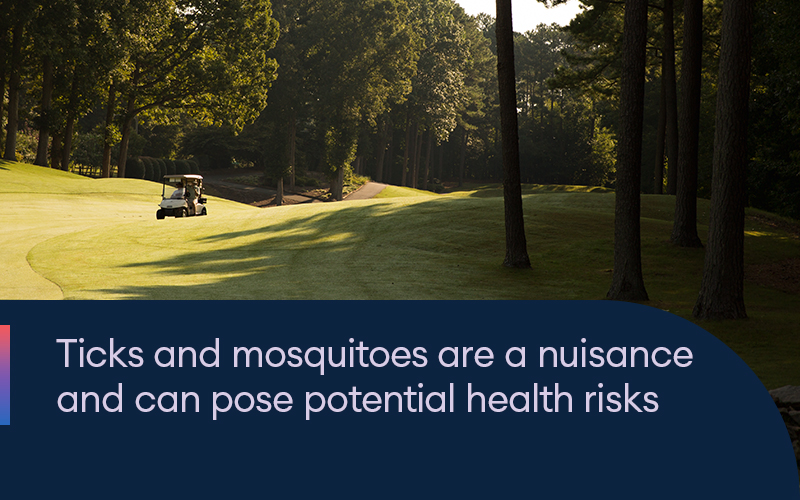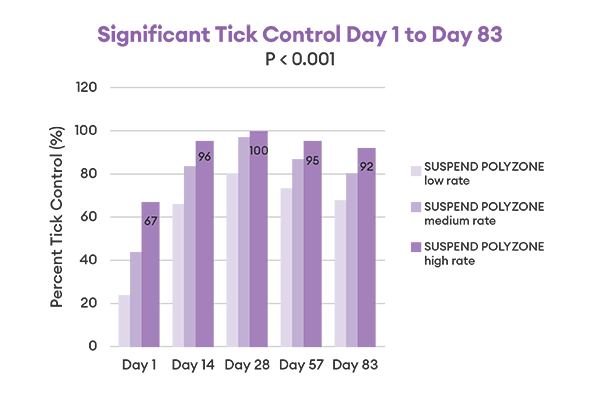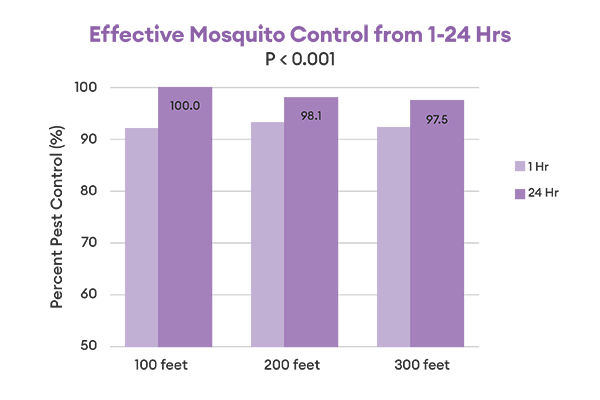Ticks and Mosquitoes: Combating Unwanted Guests on the Golf Course
Golf courses provide a well-deserved escape to nature, but ticks and mosquitos can pose potential health risks to anyone enjoying a good game of golf. Taking steps to reduce pest populations will give you and your patrons peace of mind. Understanding the pests' habitat, life cycle and disease risk and implementing preventative measures are crucial elements for a safe and enjoyable golfing experience.

Ticks: hiding in the rough
Ticks have appeared early this 2024 season, with Ontario already reporting 60 cases of Lyme disease and over 1000 black-legged tick sightings in May.1
Habitat
Ticks, particularly the blacklegged tick (Ixodes scapularis), thrive in tall rough grasses and shady moist wooded areas found at the edges of golf courses and green spaces. Golf courses are hot spots for ticks, too, because most rodent predators are deterred by the number of golfers, increasing the tick population. Golfers are typically not thinking about personal protection either, increasing their risks. A medical study from Orange County, New York, found that three-quarters of golfers reported locating ticks, with 24% testing positive for Lyme disease. In New York, only 0.2% of the population ever gets diagnosed for this disease, making golf courses a higher risk environment.2
Life cycle
There are over 40 tick species found across Canada, with 13 documented species in Ontario alone. Part of the arachnid family which includes spiders and scorpions, ticks have a four-stage life cycle: egg, larva, nymph and adult. They require a blood meal from a host (such as rodents, deer or humans) to progress to the next stage and will starve for prolonged periods between hosts, making them stick around longer. Larva primarily feed on rodents or birds as their first host, but nymphs feed on larger hosts like deer or humans and can transmit disease readily. They are hard to spot as they are about the size of a poppy seed, making them go unnoticed longer. Adults also transmit disease but are larger (sesame seed sized) and easier to spot, making them more likely to be removed early.
Disease risk
Blacklegged ticks are well-known vectors for Lyme disease, a potentially debilitating illness caused by the bacterium Borrelia burgdorferi, which infects around 20% of ticks but in some areas can be as high as 60%. Once a tick attaches, it is estimated that it takes more than 24 hours for Lyme disease to transmit, but this number is in debate since other tick-borne diseases, like the Powassan virus, is transmitted within 15 minutes, making removing a tick as soon as possible an urgent concern. Adults over 50 are particularly at risk due to an increase in outdoor activities. Lyme disease is a critical concern, and the number of cases in Canada has increased over the last 15 years, from less than 200 yearly to well over 10 times that by 2020. Prevention steps are listed below for a safer and healthier 2024 season.
For more information about ticks and how to stay safe this season, see https://www.globallymealliance.org/about-lyme/prevention/about-ticks/.
Mosquitoes: multiplying in still waters
Mosquitoes, those tiny pests we have learned to live with, are quickly becoming one of the deadliest insects in the world, according to the World Health Organization, and not simply because of malaria. Their risk to humans is due to the wide range of diseases they carry.
Here in Canada, mosquito-borne diseases (MBD) have increased by 10% because of longer and warmer seasons. Dr. Victoria Ng, a senior scientist at the Public Health Agency of Canada says that warmer seasons affect mosquitos because their life cycle depends on temperature and weather bringing an increase in potential diseases northward.3 To keep up to date with disease transmission in your province, check out the Health Canada website for real time disease data during peak transmission (July – October).
Life cycle and habitat
The mosquito life cycle consists of four stages: egg, larva, pupa and adult. Mosquitoes require standing water to breed, and golf course ponds, irrigation leaks, gutters and drains, and any container holding water are perfect breeding grounds. Females lay eggs in stagnant water. The larva and pupal stages then last about two and a half weeks before biting adults emerge. Adults live for two to three weeks on average. Females require a blood meal to produce eggs, and common hosts are animals, including birds, rodents, horses and humans.
Disease risk
There are over 80 distinct species of mosquitoes in Canada, with three species that carry up to six diseases that affect humans. The most notable is the West Nile Virus carried by the Culex pipiens and Culex tarsalis mosquito species. The Asian Tiger mosquito (Aedes albopictus) has also been reported to spread Dengue, Yellow Fever and the Chikungunya viruses but only in the Windsor Ontario region as recorded in 2020.4 The West Nile virus is primarily carried by birds who transmit it to carrier mosquitoes.4 West Nile cases vary, but 2018 saw a record 432 reported cases in Canada. Most cases go undiagnosed. Canada.ca and WHO recommend the use of deltamethrin for a 94%-100% control of mosquitoes, and Suspend PolyZone® insecticide is your best bet as a product specifically developed for use in Africa to combat MBDs like malaria.
Keys to prevention
Landscape management:
- Keep grass and vegetation well-trimmed, especially in roughs, wooded areas and ornamentals. Clear leaf litter and brush from wooded areas and remove weeds and debris for tick control. Remove standing water, clean gutters and drains, and keep ponds flowing.
Biological control:
- Encourage natural predators, like birds and bats.
- Stock ponds with fish species that feed on mosquitoes, specifically the Mosquito fish (Gambusia affinis) which is the most effective predator.
Personal Protection:
- Educate patrons to self-check for ticks and to use personal protective measures against both ticks and mosquitoes.
- Encourage use of repellents with DEET or natural repellents, like essential oils.
Chemical Treatment:
- The most effective chemical agent against mosquitoes is the active ingredient deltamethrin, found in Suspend PolyZone, a highly effective solution. Data shows almost 100% control within the first 24 hours after application and up to 300 feet from the application site of Suspend PolyZone.
- All species of ticks are also highly susceptible to Suspend PolyZone, and trials show commercially significant control (>90%) up to 82 days (about two and a half months) after application.
- Envu’s proprietary polymer allows long lasting advanced adherence on foliage and hard surfaces, even during weather events, extending the exposure time for long pest control.
- Treat areas with overgrown vegetation, forest edges, structures, and stone walls, property line perimeters, sidewalks, pathways, patios, and all structures, including dog houses, with Suspend PolyZone. See our solutions below.
Proven results:
Significant Tick and Mosquito Control:

Data from our 2015 study indicated significant control was achieved as soon as day 1 at all rates used. Commercially acceptable rates (>90%) were achieved with Suspend PolyZone high rate from day 14 all the way to day 82 and from day 28 to day 56 at medium rates (>90%).

A 2014 study shows the effects of the active ingredient of Suspend PolyZone having significant pest control within 1 hour of application and with effects up to 300 feet from application site.
References:
- Ticks: Over 1,000 sightings in Ontario, at least 60 reports of Lyme disease | CTV News
- https://www.nbcnews.com/id/wbna56489206
- https://climateatlas.ca/mosquito-borne-diseases-and-climate-change
- https://www.canada.ca/en/health-canada/services/consumer-product-safety/reports-publications/pesticides-pest-management/fact-sheets-other-resources/use-of-deltamethrin-for-mosquito-control.html
- Seasonal update - Mosquito-borne disease surveillance - Vector-borne disease surveillance in Canada — Canada.ca: www.health-infobase.canada.ca/zoonoses/mosquito/ - (biweekly updates from July to October).
ALWAYS READ AND FOLLOW PESTICIDE LABEL DIRECTIONS.
Envu, the Envu logo and Suspend PolyZone® are trademarks owned by Environmental Science U.S. LLC or one of its affiliates.
©2024 Environmental Science U.S. LLC. All rights reserved.
